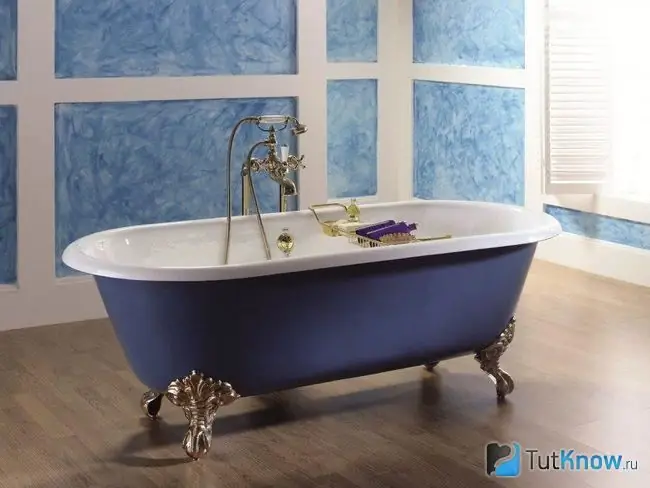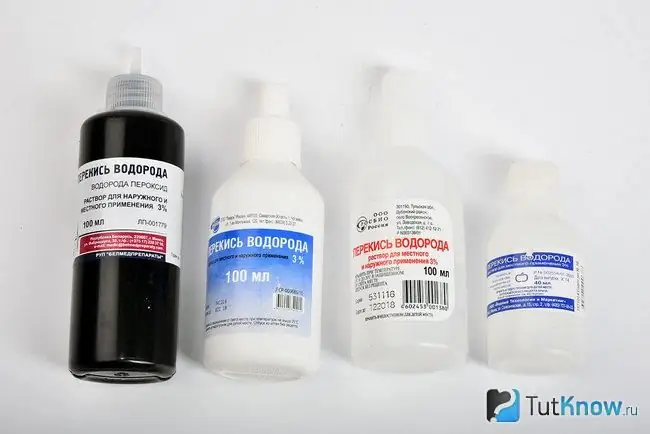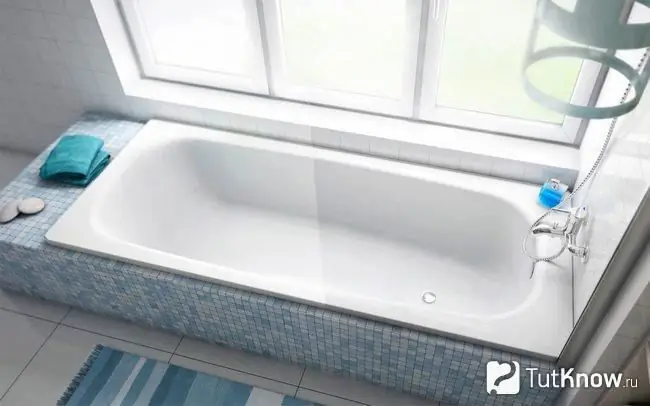- Author Arianna Cook [email protected].
- Public 2024-01-12 17:55.
- Last modified 2025-01-23 09:40.
Why does the bathroom turn yellow and rust? How to remove these plaques with improvised and industrial means? Maintenance of acrylic, cast iron and steel bathtubs. Video tips. The presence of minerals, iron and lime impurities in the water leads to the formation of yellowish and rusty stains on the bathtub. Depending on the hardness of the water, limescale appears after weeks or months. However, proper care of the bathroom will keep it clean and completely safe. Knowing how to care for your bathtub surface and learning how to deal with rust at home will keep your bathtub looking sparkling.
Varieties of bath types

Before proceeding with the elimination of bathroom contamination, you should decide on its type. Because each surface requires individual care, and improper cleaning will render the bath unusable.
- Steel.
- Cast iron.
- Acrylic.
- Glass.
- Wooden.
- Marble.
The most common are the first three types, so we'll talk about them in the article.
Why does the bathroom turn yellow and rust appears?

Even a new bathtub can acquire a yellow coating after a few months. Let's see what reasons lead to such pollution.
- Stains and yellow deposits appear due to impurities in the water, such as metal particles and chlorine compounds.
- Rusty reddish brown stains appear due to the iron content in the water, as well as the old plumbing system.
- Limestone sediment occurs due to "hard water" in which calcium and magnesium compounds are present.
What industrial products can be used to clean the bath from rust and deposits?

The shops sell a lot of household chemicals for cleaning apartments, incl. bathroom. Among them, the most effective agents are distinguished, such as Sanfor, WC 5+, Triton, PaniVanna, etc. However, people with increased sensitivity to chlorine fumes may experience allergic reactions. Then you need to use alternative cleaning agents for rust and plaque.
Handy tools for cleaning the bath from rust and deposits

Many home remedies can be analogs of household chemicals. The most effective are the following:
- Hydrochloric acid and water. Take the amount of water 2 times more acid. Apply the product to yellowed areas for 10 minutes, rinse with diluted water and washing powder. Then rinse with running water. Perform the work with gloves, and wrap the rag around an unnecessary stick.
- Hydrogen peroxide and ammonia. Mix the liquids in a ratio of 1: 2 and wipe the area with rust, leave the product for 20 minutes, then rinse with clean water.
- Vinegar and salt. Combine these substances, warm up and rinse the bath. This method is good for stubborn stains.
- Turpentine or thinner for oil paints. Apply the product to a dry surface with a sponge, leave for 10 minutes and rinse with a solution of detergent. Rinse the tub with clean water.
- Lemon acid. Dissolve 1 sachet in 200 ml of water, apply on stains for 15 minutes, then rinse with any detergent. Wear gloves.
- Whitening toothpaste. Apply the product to the affected area, leave for 20 minutes and wipe with the hard side of the sponge.
How to care for an acrylic bathtub?

To care for an acrylic bath, use soft wipes and sponges, take liquid soap or dishwashing detergent. Pour your chosen product onto a sponge and apply evenly over the entire surface and leave for 5-15 minutes to absorb. Then rub the surface with a soft washcloth and rinse with clean water.
Re-treat the remaining dirt. At the end of the procedure, a wax polish is applied to a clean and dry surface to give the surface a shine. Washing an acrylic bathtub with detergents, baking soda and other loose products will lead to tarnishing or a yellow tint. Also, their small crystals will scratch the surface.
Cast iron and steel bath care

Cast iron and steel bathtubs are covered with enamel, which is considered to be wear-resistant. However, it also loses its original appearance over time. But if you regularly monitor the surface, you will not have to wash it from rust and deposits.
Use cloths and soft sponges to clean the surface of the bathtub. Chlorine, acid and alkali will restore her shine. Detergents like Sif, Mister Muscle, Domestos, Sillite, Frosch, Sonox do a good job with this task. Protect your hands with rubber gloves so that acid does not come into contact with your skin.
Before washing the bath, cover the chrome parts with cellophane. Pour acid on damaged yellowed areas of enamel and leave for 15 minutes. Afterwards, rub the bath well with a cloth, especially in places where stains arise, and rinse thoroughly with running water.
How and what to wash the bath with - useful tips

- Do not use gasoline, abrasive paste, acetone, or alcohol to clean the bathtub.
- Do not use fiberglass sponges or wire brushes. They will damage the surface of the bathtub, as a result of which it will be necessary to carry out its restoration.
- Protect the skin of your hands with gloves, and also make sure that the acid does not get on your face.
- To avoid allergic reactions, wear a respirator, since the vapor of the funds will go into the respiratory tract.
- Do not soak dirty laundry with powder in the bathroom. Particles of the product will corrode the coating.
- You cannot overdo it with cleaning. It is enough to clean cast iron and steel products once a week, acrylic - in 14 days.
- Do not leave metal objects in the bathroom, they tend to rust.
Video tips on how to clean your bathtub at home:
How to clean your bathtub and remove rust stains

How to clean a bathtub, faucet and limescale






